Cabinet hardware might look like a minor detail, but honestly, it can totally change your kitchen or bathroom. The knobs, pulls, and handles you pick act like jewelry for your cabinets, bringing both function and style to your space.
Remember to repin your favorite images!
The right hardware will elevate your cabinetry from ordinary to extraordinary, pulling your whole design together for a finished look.
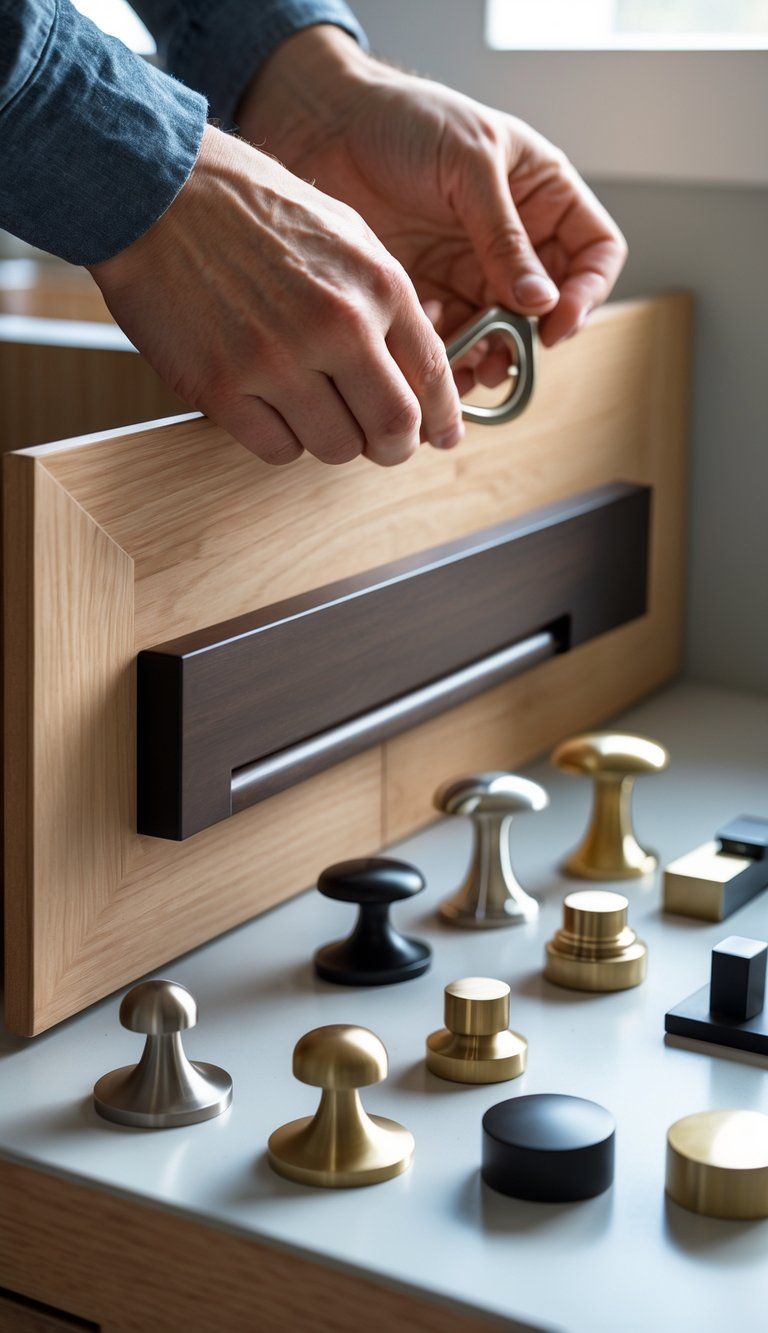
When you choose cabinet hardware, think about both finish and style to match your overall vibe. Dark cabinets pop with copper or rose gold, while lighter ones might need some contrast with darker hardware.
What kind of atmosphere do you want? Sleek modern pulls for that contemporary feel, or maybe some wooden knobs for a cozy, natural look?
You’ll want hardware that looks great and feels good to use. The pieces should fit comfortably in your hand and actually make your daily life easier.
Mixing affordable knobs with a few high-end pulls in prominent spots can make your space feel luxe without blowing your budget. Plus, hardware is one of the simplest things to swap out later if you ever want a refresh.
Understanding the Importance of Cabinet Hardware
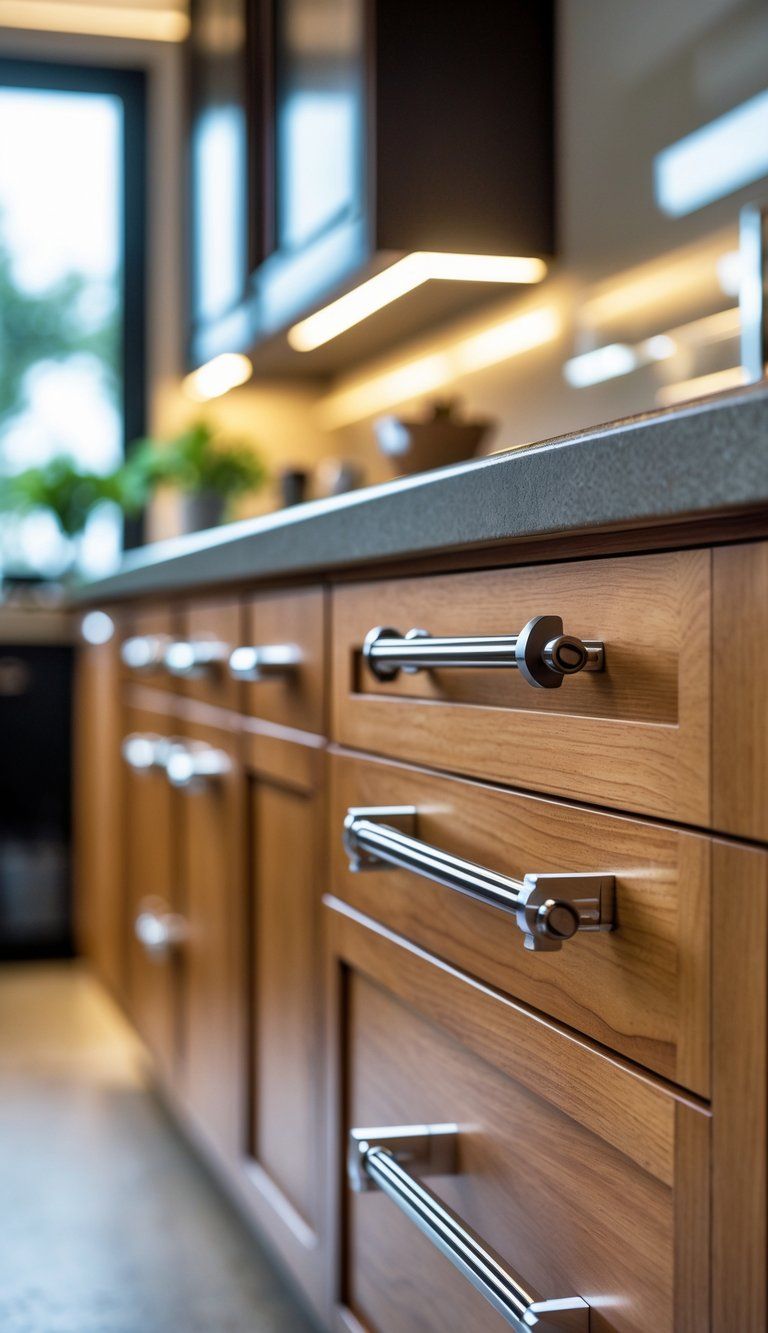
Cabinet hardware might seem like a small thing, but it’s crucial for both the look and function of your cabinets. The right knobs or pulls can turn basic cabinets into the stars of your home.
How Hardware Influences Cabinetry Aesthetics
Cabinet hardware really is the “jewelry” of your cabinets. Like a great watch or necklace, it adds that finishing touch and can truly elevate your whole space.
The finish—brushed nickel, matte black, antique brass, whatever—creates visual interest and can tie your whole room together.
The style says a lot too. Modern, sleek handles fit contemporary cabinets, while ornate knobs feel right at home with traditional designs.
If you match hardware to your design theme, you get a look that feels intentional and put-together.
Size matters here. Oversized pulls make a statement on big doors, while small knobs work well for daintier drawers.
Getting the proportions right means your hardware will enhance the cabinets, not overpower them.
The Role of Hardware in Functionality
Looks aren’t everything; hardware also affects how your cabinets work day-to-day. Good pulls and knobs should feel comfortable and make opening and closing cabinets easy.
Think about how you use your space. Kitchens see a lot of traffic, so you might want chunky handles that are easy to grab, even with messy hands.
In bathroom vanities, you might prefer hardware that’s easy to clean and stands up to moisture.
Where you place your hardware matters too. Handles at the right height will save you from stretching or bending. Heavy drawers need stronger hardware that won’t loosen or break with use.
Practical tip: Try out different hardware before installing. Hold it, pretend to open a cabinet, and see how it feels.
Hardware as a Design Decision
Choosing cabinet hardware is a bigger design decision than most people realize. It’s one of the first things people notice, and it can totally change the vibe of your space.
Hardware helps you:
- Define your style (modern, farmhouse, traditional…)
- Add personality to plain cabinets
- Create contrast or harmony with your cabinet color
- Update your space without a full remodel
Look at the big picture when picking hardware. Does it work with your cabinet color? Does it play nicely with other metals in the room, like faucets or lights?
The best designs coordinate these elements without making everything match too perfectly.
Budget matters too. High-quality hardware costs more but usually lasts longer and works better. It’s a little investment in how your home looks and feels.
Types of Cabinet Hardware
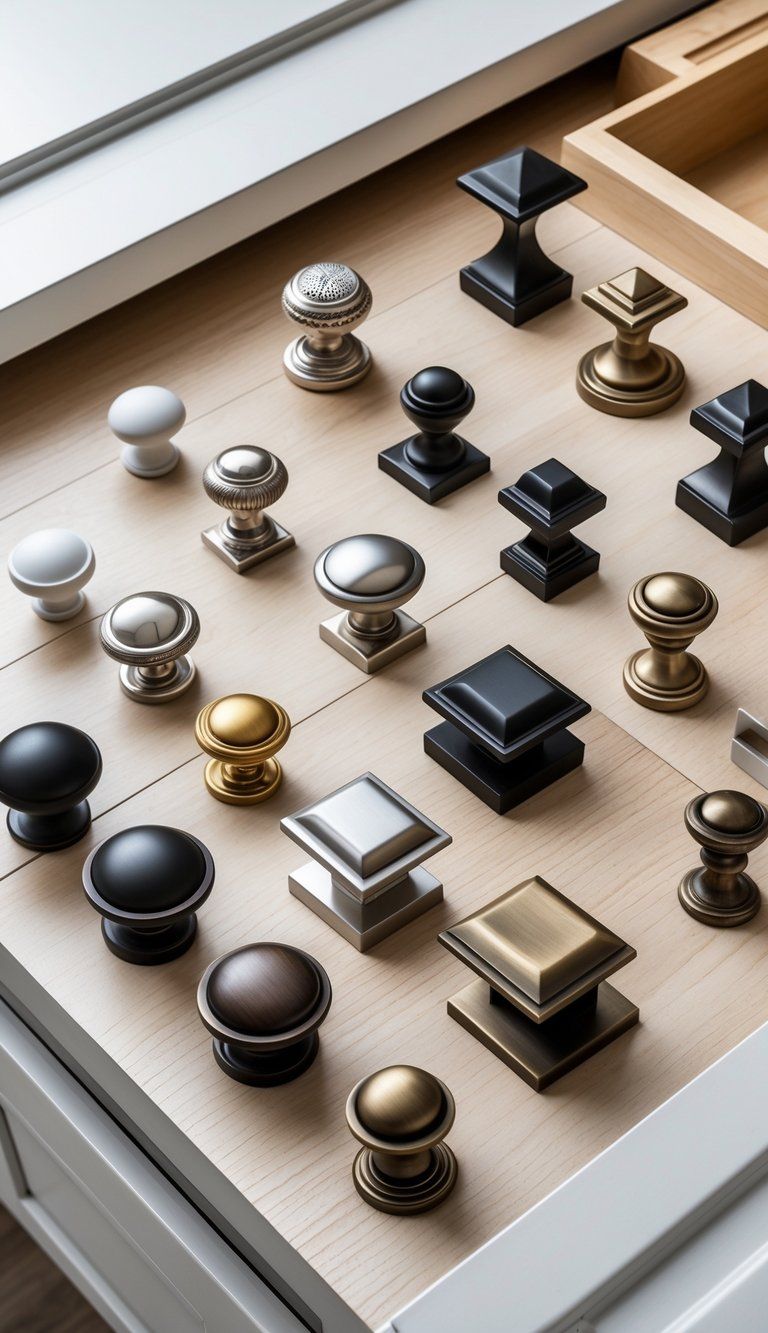
Cabinet hardware isn’t just functional—it’s a design element that can totally transform your cabinets. The right choice can elevate your kitchen, bathroom, or any cabinetry in your home.
Knobs and Pulls Overview
Knobs are small, usually round or square, and need just one screw. They’re great for cabinet doors or smaller drawers that don’t need a lot of force to open.
You’ll find cabinet knobs in all sorts of materials, like:
- Metal: brass, bronze, chrome, nickel
- Glass or crystal: perfect for elegant, traditional spaces
- Ceramic: colorful and casual
- Wood: keeps things natural and cohesive
Size matters here too. Most knobs are around 1-1.5 inches wide, but larger ones (up to 2 inches) really stand out.
For modern kitchens, try stainless steel or chrome knobs with simple lines. Traditional spaces look great with detailed bronze or brass knobs.
Handles and Cabinet Pulls
Cabinet pulls use two screws and give you more to grab onto than knobs. They’re perfect for bigger drawers or cabinets you open a lot.
Common pull styles:
- Bar pulls (straight handles)
- Cup pulls (half-moon shapes)
- Bail pulls (upside-down U)
- Finger pulls (recessed designs)
Here’s a quick sizing cheat sheet:
- Drawers under 24 inches: 3-4 inch pulls
- Drawers 24-36 inches: 4-8 inch pulls
- Drawers over 36 inches: 8+ inch pulls or even two smaller ones
Put pulls horizontally on drawers and vertically on doors for a clean look. Keep them at the same height on doors for consistency.
Test out different shapes in your hand before you commit to hardware for your whole kitchen. Comfort matters more than you might think.
Hinges and Door Slides
You don’t really see hinges and slides, but they’re essential for how your cabinets work. Quality here is key because these parts get daily use.
Common hinge types:
- Concealed hinges: hidden when doors are closed
- Overlay hinges: visible on the outside
- Inset hinges: visible when doors are open
- European hinges: adjustable in several directions
For drawers, the slides make a difference. Ball-bearing slides run smoother and hold more weight than basic roller slides.
Soft-close features stop slamming and protect both cabinets and fingers. They cost more, but if you use your cabinets a lot, they’re worth it.
Try to match hinge finishes to your knobs and pulls for a unified look, or pick concealed hinges if you’d rather not see them at all.
Materials Used in Quality Hardware
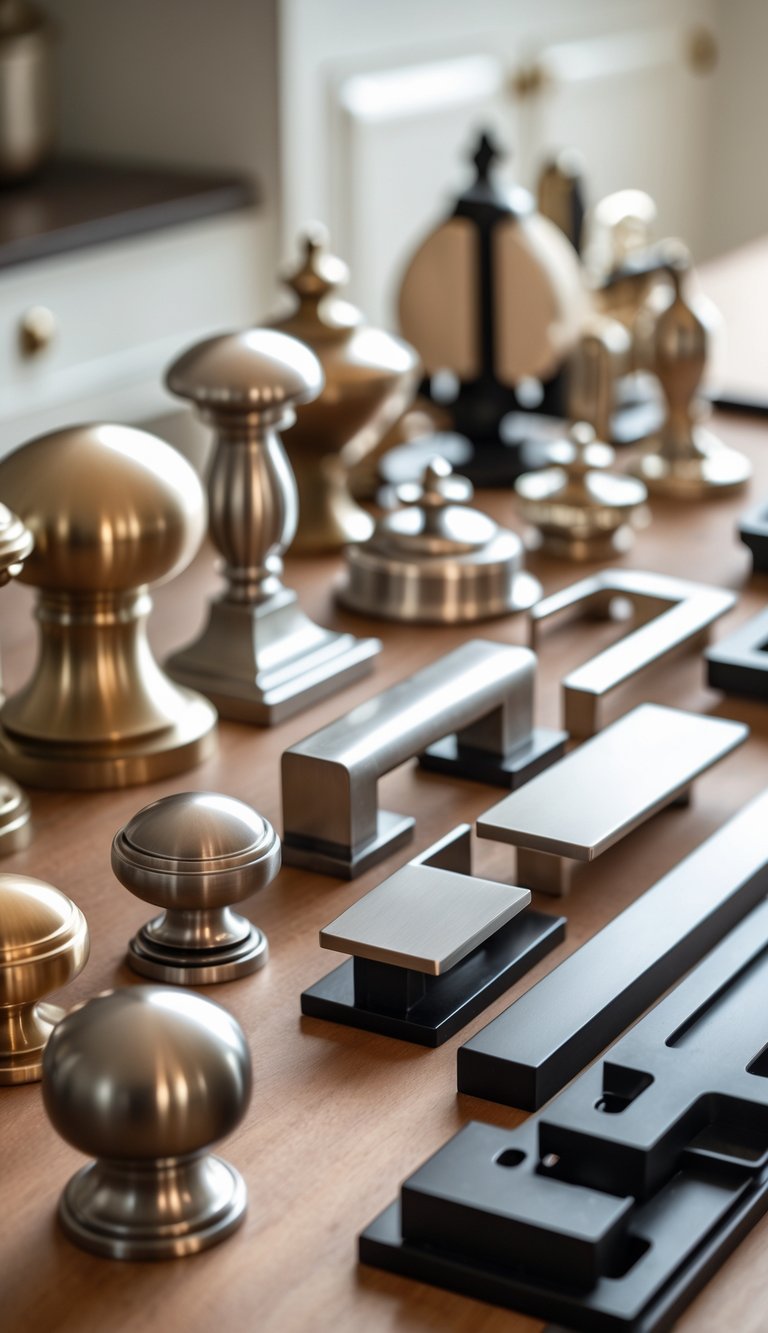
The material you pick for your cabinet hardware affects how it looks and how long it lasts. The right choice strikes a balance between style, durability, and daily function.
Solid Brass and Brass Hardware
Solid brass hardware is often called the gold standard for cabinet fixtures. Unlike plated pieces, solid brass won’t chip or peel.
Over time, it develops a rich patina that a lot of homeowners love. Brass hardware comes in finishes like polished, brushed, or antique, so you can get different looks while keeping that warm brass feel.
Brass resists corrosion from moisture and hand oils, so it’s great for kitchens. It’s usually pricier than other options, but you get what you pay for.
Check for labels like “solid brass” instead of just “brass finish” to make sure you’re getting the real thing, not just a coating.
Stainless Steel, Zinc, and Alloy Choices
Stainless steel hardware is super durable and has a clean, modern look. It stands up to moisture, so it’s perfect for kitchens and bathrooms.
Zinc alloy is a more affordable choice that still offers good quality. Manufacturers cast these pieces, which allows for more detailed designs and lower prices. Many zinc fixtures come with protective finishes like chrome or nickel.
Aluminum is lightweight and resists rust and corrosion, making it a smart pick for coastal homes where salt air can be tough on other metals.
Bronze hardware has a deep reddish-brown color and brings both elegance and durability. It fits beautifully in traditional and craftsman-style homes.
Glass, Ceramic, and Alternative Materials
Glass hardware adds a little sparkle. Clear crystal knobs brighten up traditional spaces, while colored glass feels more eclectic.
Most glass pieces are mounted on metal bases to keep them sturdy. Ceramic knobs bring a lot of charm to country or cottage kitchens and come in endless colors and patterns.
Ceramic is a bit more fragile, but quality pieces can last for decades if you treat them right. Copper hardware starts off shiny but darkens over time, developing a unique patina unless you polish it regularly.
If you’re picking alternative materials, think about how much use they’ll get. Some of the more decorative options are better for cabinets you don’t open every day, like china hutches.
Exploring Hardware Finishes
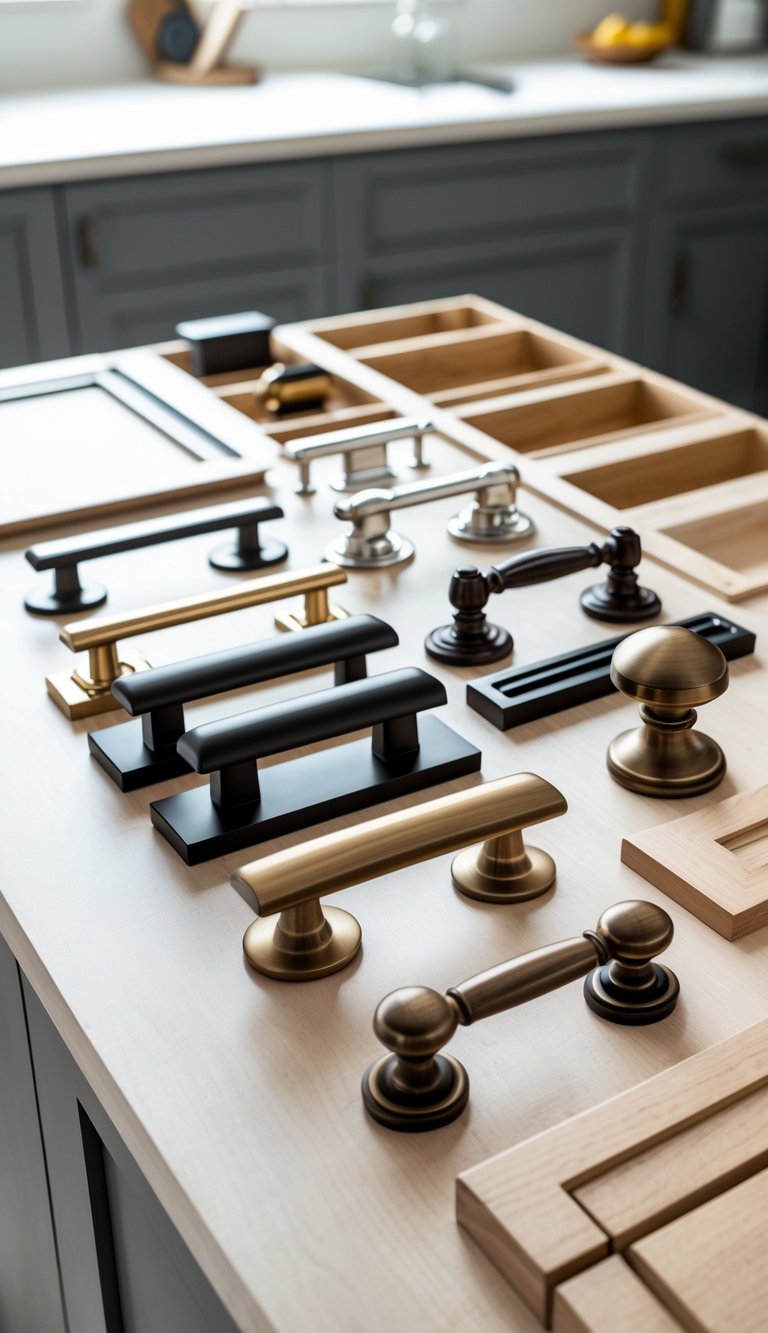
Hardware finishes can totally define the look and feel of your cabinets. The right finish will turn basic cabinets into eye-catching features and help tie your whole design together.
Popular Finishes: Brushed Nickel and Polished Chrome
Brushed nickel is one of the most popular finishes for cabinet hardware. Its soft, matte look hides fingerprints and water spots better than shinier finishes.
It works in both classic and modern spaces. Polished chrome, on the other hand, gives you that mirror-like shine and really brightens up a room.
It’s especially nice in modern or mid-century kitchens. Chrome is:
- Durable
- Easy to clean
- Resistant to corrosion
- More affordable than some specialty finishes
If you’re deciding between these two, think about your cleaning habits. Brushed nickel is less fussy, while polished chrome is bolder but needs more wiping.
Matte Black, Oil-Rubbed Bronze, and Gold
Matte black hardware is everywhere lately, and for good reason. It pops against light cabinets and adds a dramatic, sophisticated edge.
Oil-rubbed bronze brings warmth with its dark finish and subtle copper hints. It ages nicely, picking up a lived-in patina that’s hard not to love.
Gold finishes are back in a big way, and they come in several flavors:
| Gold Finish Type | Characteristics | Best Paired With |
|---|---|---|
| Polished Brass | Bright, yellow-gold shine | Traditional, glam styles |
| Aged Brass | Darker with antique patina | Vintage, rustic designs |
| Champagne Gold | Subtle, light gold tone | Transitional, contemporary |
Gold hardware feels luxe and looks amazing against navy, green, or white cabinets.
Mixed Metals and Unique Finishes
Mixing metals adds depth and interest if you do it right. The trick is to pick a main finish and use another as an accent.
For example, brushed nickel faucets with brass pulls can look intentional, not mismatched.
Some unique finishes to consider:
- Copper: Warm and changes over time
- Pewter: Soft, antique gray
- Gunmetal: A dark, industrial look between black and silver
Try to stick to two or three complementary finishes. Too many and things can start to look chaotic.
Matching Hardware Finish to Cabinet Color
Let your cabinet color guide your finish choice. White or light cabinets are the most flexible—almost any finish works, so it’s all about how much contrast you want.
Medium wood cabinets look great with oil-rubbed bronze or antique brass for warmth, or with brushed nickel or chrome for a more modern feel.
Dark cabinets really shine with finishes that stand out. Think polished chrome or nickel for crisp contrast, gold or brass for warmth, or matte black for a subtle, moody vibe.
Pay attention to undertones. Warm cabinets pair best with gold or bronze, while cool-toned cabinets look fantastic with silver-toned hardware.
Choosing Hardware That Complements Cabinet Styles
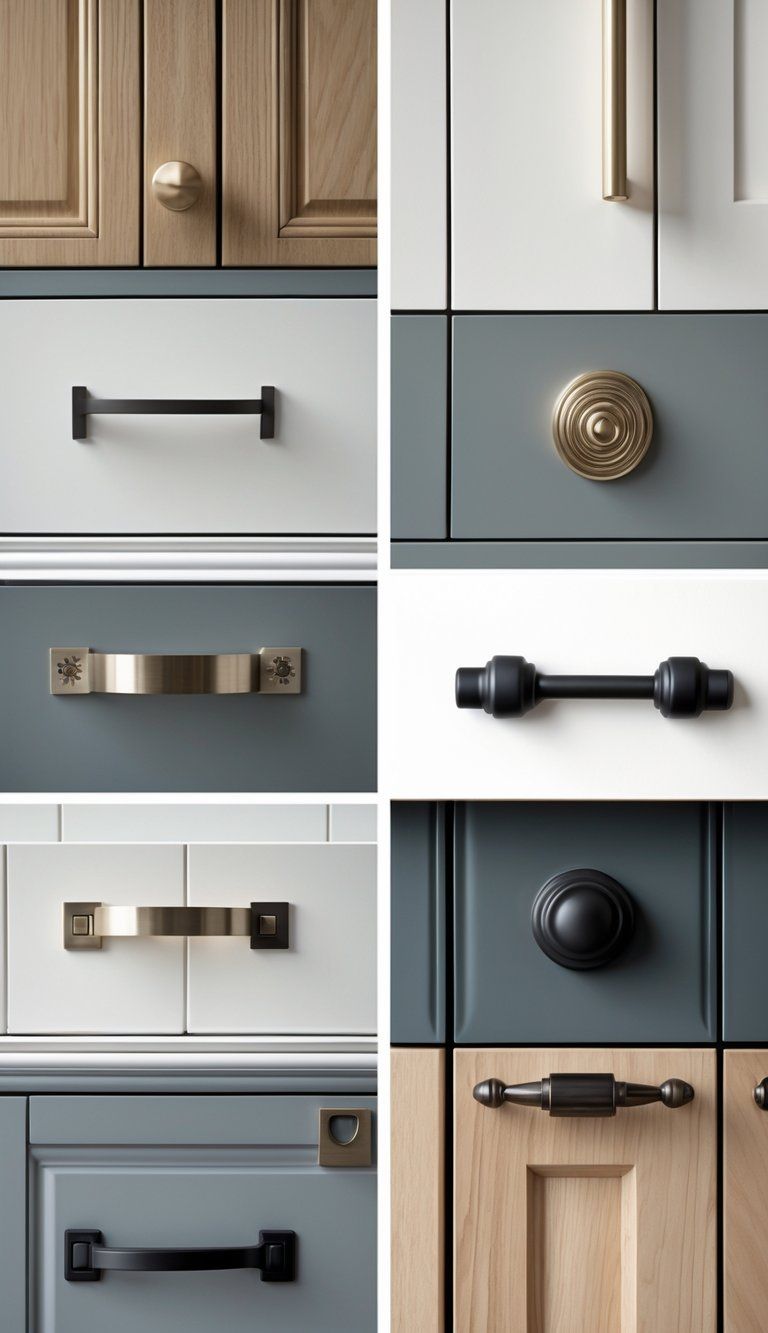
The right hardware can totally change the vibe of your cabinets. Every cabinet style has hardware that brings out its personality and design quirks.
Traditional Cabinets and Classic Styles
Traditional cabinetry really comes alive with hardware that shows off its craftsmanship. Cup pulls and ornate knobs in brass, bronze, or pewter give these cabinets a big dose of character.
Best Hardware for Traditional Styles:
- Bin pulls with backplates
- Drop handles with decorative motifs
- Knobs with intricate patterns
- Bail pulls with curved profiles
You want the hardware to feel solid in your hand. For traditional kitchens, go for pieces with rounded edges or gentle curves.
These touches echo the detail you see in raised-panel doors and crown molding. Antique brass or oil-rubbed bronze finishes add that cozy, lived-in warmth that fits traditional cabinetry.
Modern and Contemporary Kitchen Designs
Modern kitchens really embrace sleek, simple hardware. In these spaces, less really is more.
For modern style cabinets, try:
- Straight bar pulls
- Integrated finger pulls
- Hidden touch-latch mechanisms
- Tab pulls with clean lines
Modern hardware usually comes in:
- Simple geometric shapes
- Matte black or brushed nickel finishes
- Minimal ornamentation
- Consistent sizing
A lot of modern kitchens use long, horizontal pulls that run the length of flat-panel doors. It keeps things looking clean and uncluttered.
If you’re after a super modern look, try handleless cabinets with push-to-open hardware or recessed finger pulls. It keeps the surfaces totally smooth.
Rustic and Eclectic Looks
Rustic kitchens love a bit of imperfection and natural texture. Hardware should feel authentic and maybe even a little rough around the edges.
Rustic hardware favorites:
- Hand-forged iron pulls
- Leather loop pulls
- Hammered copper knobs
- Distressed brass handles
For farmhouse cabinets, hardware with an imperfect finish suggests age and character. Black iron hardware pops against white cabinets, especially in country kitchens.
Eclectic designs open the door to mixing things up. Pair vintage glass knobs with modern pulls, or use different hardware on upper and lower cabinets. Just find a common thread—maybe the finish or size—that keeps it feeling intentional.
Adapting Hardware to Cabinet Colors
Cabinet color plays a big role in which hardware works best. Dark cabinets look awesome with lighter hardware that stands out.
Color pairing guidelines:
| Cabinet Color | Recommended Hardware |
|---|---|
| White cabinets | Oil-rubbed bronze, matte black, brass |
| Wood tones | Brushed nickel, chrome, black |
| Dark cabinets | Brushed gold, chrome, crystal |
| Colored cabinets | Complementary metal tones |
Think about undertones, too. Warm woods like cherry or oak work with brass and bronze, while cool grays or blues shine with chrome or nickel.
If you’ve got two-tone cabinets, you can either match hardware for unity or pick different hardware for each color to highlight the contrast.
Selecting the Right Hardware Size and Placement
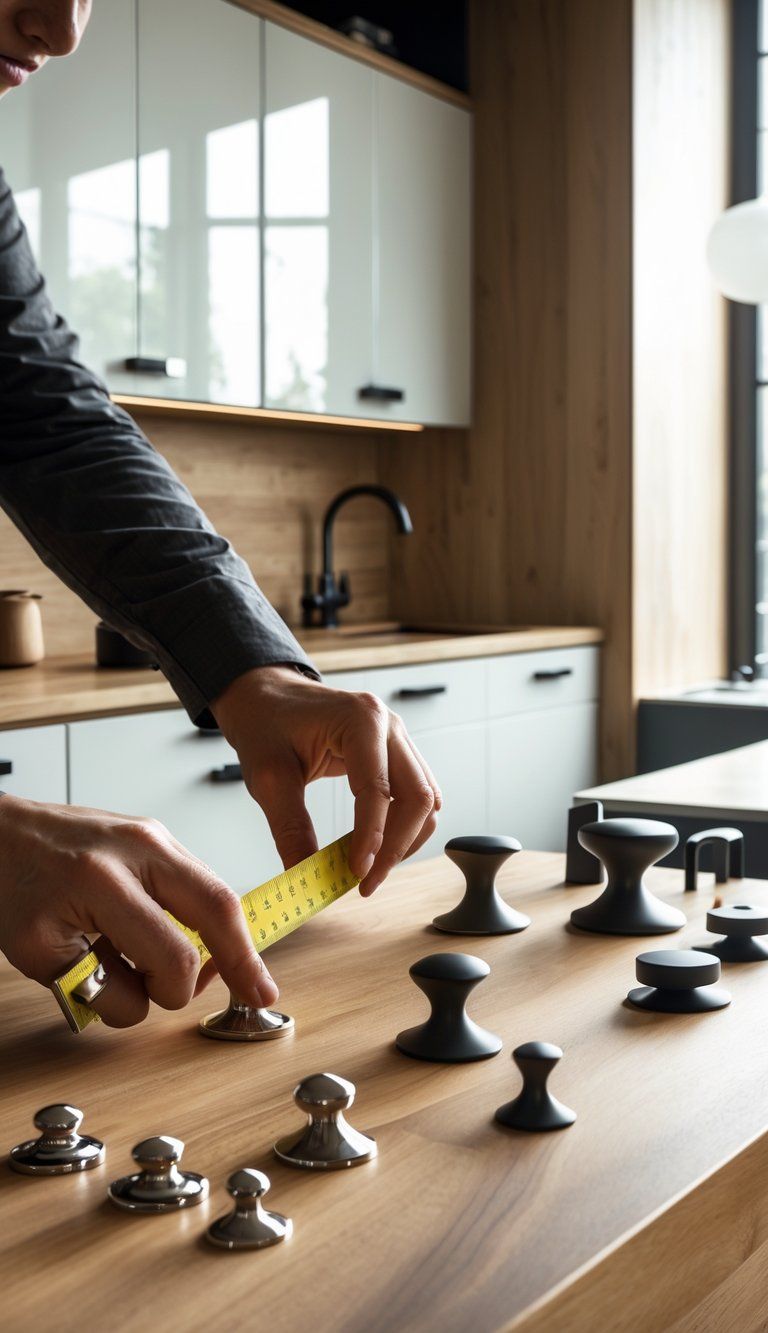
Hardware size and placement really impact how your cabinets look and work. If you get these details right, your cabinetry stands out and feels good to use.
Hardware Sizing Considerations
Most kitchens and bathrooms work well with knobs about 1-1/4″ in diameter. They’re easy to grip and feel comfortable.
For pulls, pick a length that suits your cabinet size. Standard drawers under 24″ wide usually look best with 3″ to 4″ pulls.
Wider drawers (24″ and up) need 4″ to 8″ pulls to stay balanced. Oversized pulls (8″+) make a bold statement on big cabinet fronts.
Pulls need to stick out enough so you can grab them easily—usually 1″ to 1.5″ projection works well.
Quick Sizing Guide:
- Small cabinets/drawers: 3-4″ pulls or 1-1/4″ knobs
- Medium cabinets/drawers: 4-6″ pulls
- Large cabinets/drawers: 6-8″+ pulls
Proportion and Balance
Hardware should look the right size for your cabinets. If it’s too small on big doors, it just looks lost. Oversized hardware on little drawers feels out of place.
A good trick: pulls should be about 1/3 the width of the drawer front. On tall upper cabinets, vertically-mounted pulls that are about 1/3 the door height look balanced.
Modern cabinets with clean lines often pair well with longer pulls. Traditional styles usually suit modest-sized knobs or bin pulls.
Heavy, chunky cabinets can handle bigger, bolder hardware. Lighter, delicate cabinets look better with smaller, more refined options.
Placement for Functionality and Aesthetics
For Cabinet Doors:
- Place knobs 2.5″ to 3″ from the corner opposite the hinges
- Mount horizontal pulls 2.5″ to 3″ from the bottom of upper doors or top of lower doors
- On tall doors, you might want to center the pull or use two
For Drawers:
- Center knobs both ways on small drawers
- For pulls, center them horizontally and put them about 1/3 down from the top edge
- On wide drawers (30″+), use two pulls spaced evenly
Keep your measurements consistent throughout the space. If accessibility is a concern, adjust the height as needed.
Before you install, try out the hardware. Make sure it’s comfy to grab and doesn’t have sharp edges that snag your clothes.
Balancing Aesthetics and Personal Style

Picking cabinet hardware is a chance to let your personality shine. The right pieces pull the whole look together and add those little details that make your home feel like you.
Creating a Cohesive Design
Think about your home’s overall style when you choose hardware. Modern homes usually look best with straight-line pulls, while traditional spaces can handle ornate knobs.
Consider these elements to keep things harmonious:
- Cabinet color and material: Dark hardware stands out on light cabinets, while brass or gold warms up cool tones
- Room architecture: Pick hardware that echoes the curves or angles in your home
- Existing fixtures: Coordinate with your light fixtures, faucets, and appliances
You don’t have to match everything perfectly. It’s usually better to coordinate than to go for identical finishes. If you’ve got stainless appliances, brushed nickel or chrome hardware creates a nice flow without being too matchy.
Mixing Finishes for Visual Interest
Sometimes breaking the rules is what makes a space interesting. Mixing hardware finishes can add depth and personality if you do it with purpose.
Try these ideas:
- Pair matte black pulls with brass knobs for a cool, modern vibe
- Use different hardware styles but stick to the same finish family (like all warm metals)
- Put statement hardware on your island and keep the rest simple
Just be intentional about it. Too much random mixing looks messy, but thoughtful combos feel designed. As a rule of thumb, stick to 2-3 finishes in one space.
Mixing hardware types works too. Pulls are easier for drawers, knobs make sense for doors. It adds visual interest and improves functionality.
Personal Preferences and Expressing Style
Your hardware should fit your personality and how you use your kitchen. This is where you get to really make it yours.
Think about:
- Comfort: Try the hardware in your hand before buying it
- Daily use: If you’ve got kids or a busy household, go for durable and easy-to-clean options
- Longevity: Pick something you’ll like for a while, not just what’s trending
If you love vintage, glass knobs or antique brass pulls might make you smile every time you open a door. Minimalists might prefer sleek tab pulls or hidden touch-latch systems.
And honestly, hardware is easy to swap out later. Start simple if you’re unsure, then upgrade as your taste or confidence grows.
Durability and Quality Considerations
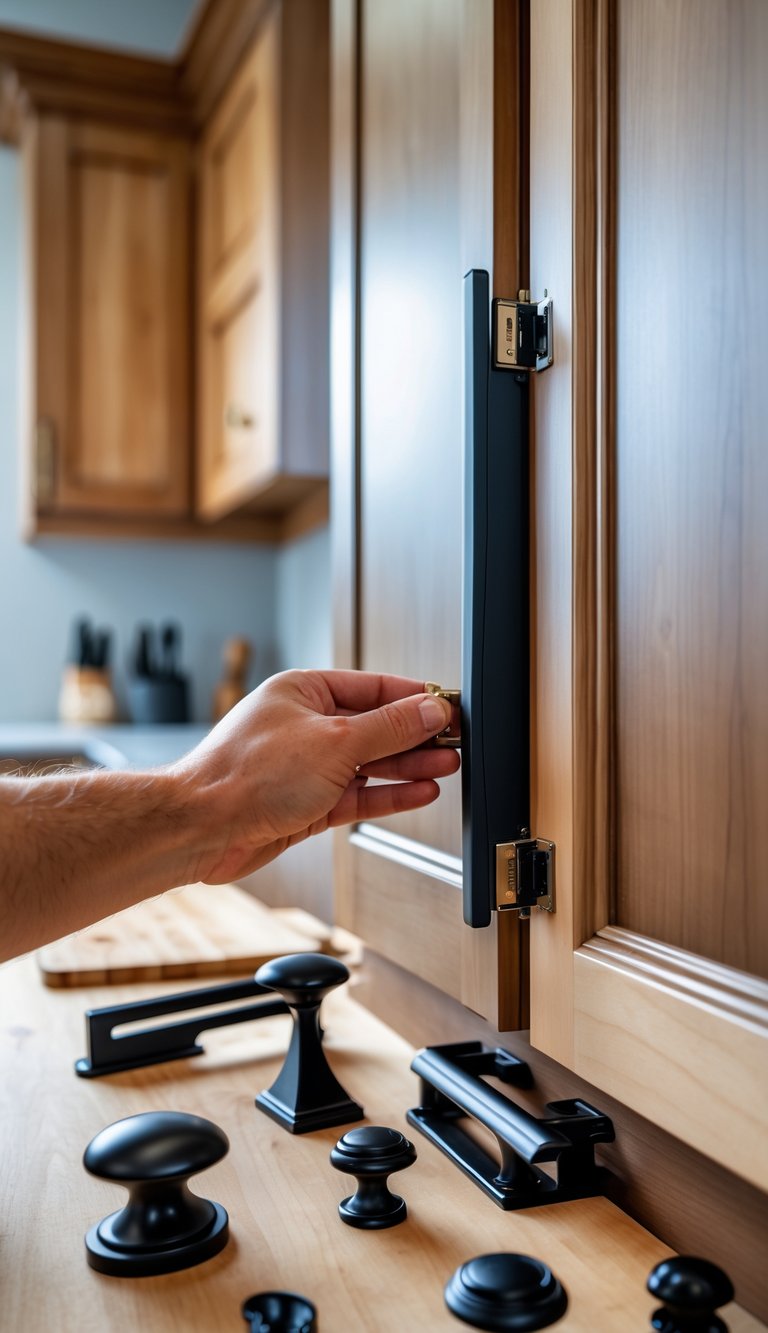
Quality hardware lasts longer and just feels better day after day. Materials and construction really do matter for how your cabinets hold up.
Durable Materials for Longevity
Solid brass stands up to moisture and daily use, making it a great pick for kitchens and bathrooms. It costs more, but brass hardware can outlast cheaper options by decades.
Stainless steel offers solid durability at a mid-range price. It resists rust, doesn’t tarnish, and survives plenty of cleaning.
Zinc alloy hardware is budget-friendly and holds up okay, but it might show wear faster if you use it constantly.
Best materials by environment:
- High-moisture areas: Solid brass, marine-grade stainless steel
- High-traffic kitchens: Solid brass, stainless steel
- Low-traffic areas: Quality zinc alloy, aluminum
Skip plastic hardware on cabinets you use a lot. It just doesn’t last.
Evaluating High-Quality Hardware
Heavier hardware usually means it’s solid and well-made. Light, hollow pieces just don’t hold up the same.
Check the moving parts too. Drawer slides should glide smoothly, and hinges should open and close quietly.
Look for tight construction and smooth edges. You shouldn’t see rough spots or seams.
Quality indicators:
- Even finish with no bubbling or flaking
- Smooth edges all around
- Solid, weighty feel
- A warranty of 5+ years (shows the maker stands behind it)
Price can hint at quality, but plenty of mid-range brands offer great value if you do your homework.
Ensuring Comfort and User Experience
Ergonomics matter. Pulls should fit your hand, and knobs should be easy to grab.
Mount hardware about 2.5 to 3 inches from cabinet edges for comfortable access. On upper cabinets, a little lower placement can help.
For anyone with arthritis or limited strength, D-shaped pulls are easier than knobs. Wider pulls (3-5 inches) spread out the pressure and feel better in your hand.
Try out hardware before installing it everywhere. Open and close drawers a bunch of times to see if it works for you.
If you have kids around, look for hardware with rounded edges and maybe even childproof options for certain cabinets.
Pick hardware that feels good for your daily routine, not just what looks cool in a catalog.
Installation Tips and Practical Advice
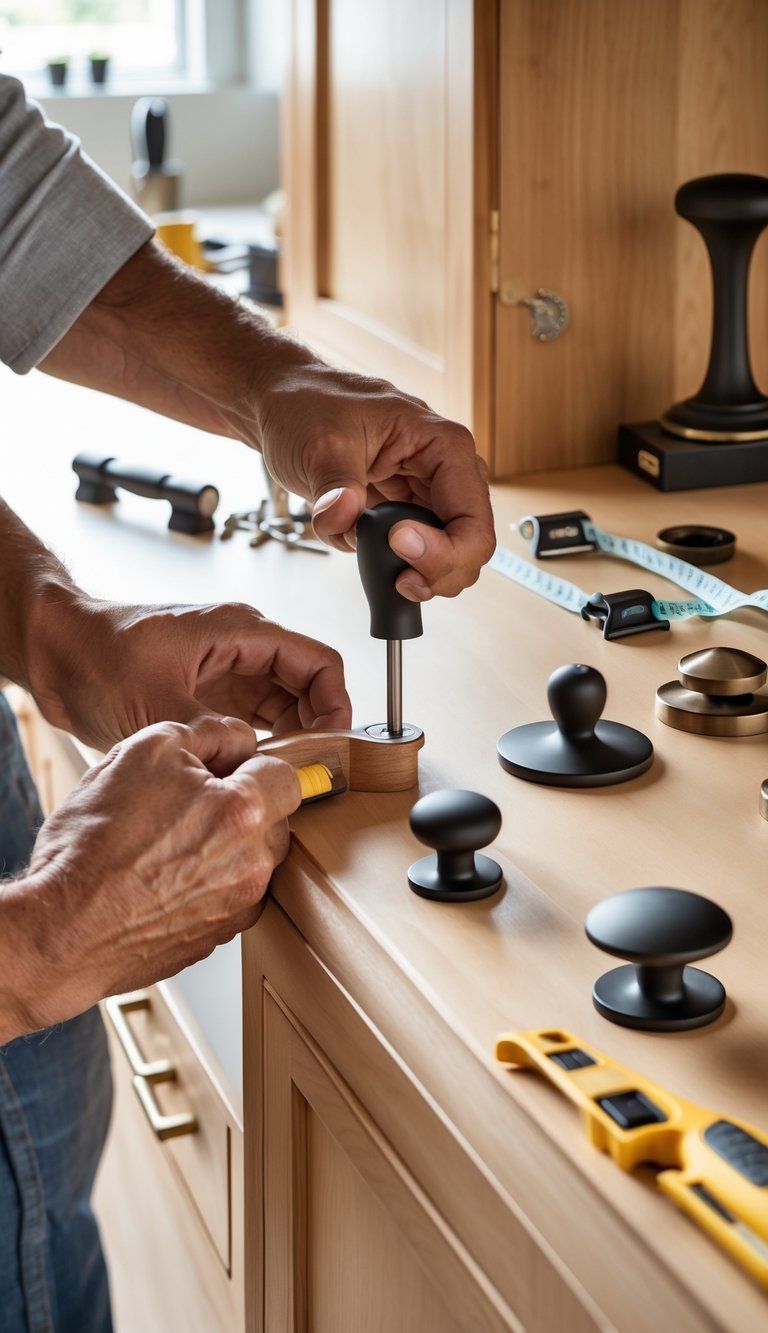
A good installation makes your hardware look sharp and work smoothly. Taking your time with placement and technique pays off in the long run.
DIY Installation Guidelines
Grab these tools:
- Tape measure and pencil
- Drill with the right bits
- Hardware installation template (super helpful)
- Screwdriver
- Level
Measure twice, drill once. Mark all your spots with a pencil before you make any holes. For consistency, use a template made from cardboard or pick up a hardware jig at the store.
Standard placement:
- Door knobs: 2-3 inches from the corner opposite the hinges
- Drawer pulls: center them horizontally, about 1/3 down from the top edge
- Bar pulls: center them, with screws 3-5 inches apart depending on the cabinet
On bottom drawers in a stack, try mounting hardware a little higher than center. It looks more balanced and feels better to use.
Professional Installation Advice
When should you hire a pro?
-
If your kitchen layout feels complicated or you’ve got a lot of cabinets
-
When you’re dealing with delicate or high-end cabinet finishes
-
If your hardware needs super precise installation
-
When you’re short on time or not feeling up for a DIY project
A professional installer can make the whole process smoother and more accurate. Most charge somewhere between $2 and $5 per hardware piece, plus a base fee—usually $50 to $100, but it depends on your area.
Ask installers if they’ve worked with your cabinet material before. Drilling into wood, laminate, or metal all takes a different approach.
Before your installer arrives:
-
Organize and count all your hardware
-
Empty out the cabinets so they’re easy to reach
-
Decide exactly where you want each handle or knob
-
Clear away anything that might get in the way
Hardware Replacement and Maintenance
If you’re replacing old hardware, you’ll need to measure the existing hole spacing carefully. Take an old handle with you when you shop, or measure the center-to-center distance between the screw holes.
If your new hardware doesn’t fit the old holes, try using backplates to cover them. You can also fill old holes with wood filler and drill new ones.
Maintenance tips by finish:
- Brass and bronze: just use a soft cloth, skip harsh cleaners
- Stainless steel: mild soap and water, then buff with microfiber
- Oil-rubbed bronze: only dust, don’t get it wet
- Painted finishes: stick to gentle cleansers, nothing abrasive
Tighten up any loose hardware every few months with a screwdriver. Once a year, rub some clear furniture wax on wooden knobs to keep them from drying out or cracking.
Humidity swings with the seasons can change how hardware fits. Sometimes you’ll need to make tiny adjustments as wood expands or shrinks.
Budgeting for Cabinet Hardware Upgrades
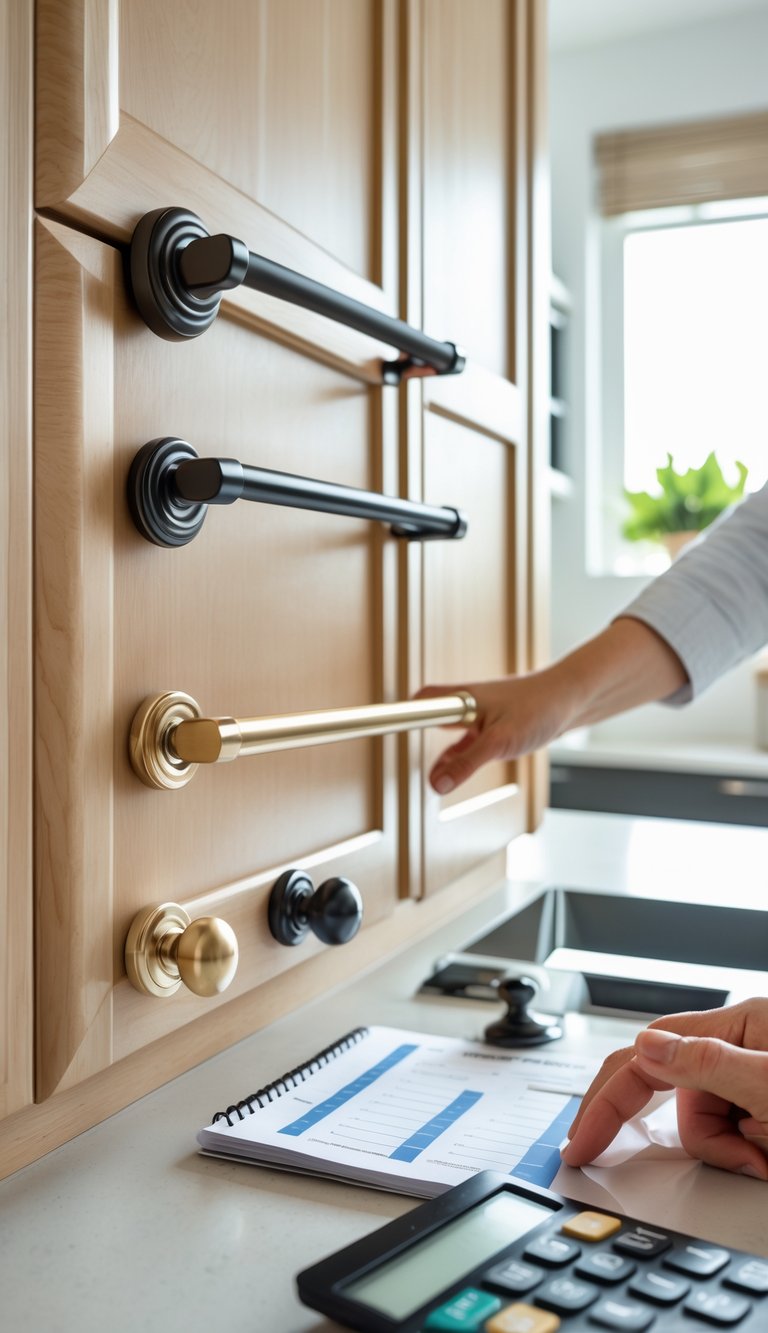
Upgrading cabinet hardware can totally change your kitchen’s vibe—and it doesn’t have to cost a fortune. If you balance cost, quality, and style, you’ll get the most out of what you spend.
Budget-Friendly Hardware Options
Looking for affordable cabinet hardware? You’ve got options:
- Big box stores sell basic knobs and pulls for as little as $2-5 each
- Hardware outlet websites often run sales, sometimes slashing prices by 25-40%
- Buying in bulk can drop the price by 10-15% if you need 20 or more of the same piece
Mixing materials helps too—painted metal or good-quality plastic can look surprisingly upscale. Lots of brands now make budget lines that mimic their fancier collections, just with cheaper production methods.
If you’re really watching your wallet, try refinishing your old hardware. A can of spray paint made for metal costs under $20 and can make your cabinets look brand new.
Investing in Quality vs. Cost Savings
Budget hardware works, but sometimes it’s worth spending more:
- High-touch spots—like the cabinets you open every day—need sturdier hardware
- Statement pieces on an island or glass-front cabinets can be worth a splurge
- Finish matters—unlacquered brass or hand-rubbed bronze ages gracefully, while cheap finishes might chip
Solid, heavier hardware usually means better quality. If it feels weighty in your hand, that’s a good sign.
You don’t have to go all-in everywhere. Invest in quality for the cabinets you use and see the most, and pick more affordable hardware for utility or upper cabinets that don’t get much action.
Long-Term Value of Hardware Selection
Smart hardware choices can add value for years, not just right after installation. You get more than a quick visual upgrade when you pick the right pieces.
Hardware with timeless designs keeps your space looking fresh. Classic bin pulls or simple knobs just never seem to go out of style.
Manufacturers show confidence in their products by offering solid warranty coverage. Some premium brands even back their hardware with 5-10 year guarantees against things like finish wear or mechanical issues.
Think about the hassle of upkeep down the road. Polished chrome, for example, tends to show every single fingerprint, so you’ll probably end up cleaning it a lot. Brushed nickel or matte black hides smudges better, which is honestly a relief in a busy kitchen.
When you choose hardware that fits your home’s architecture, you create a sense of cohesion. That detail might not seem huge now, but it can make your place more appealing to future buyers—without needing a big renovation.

